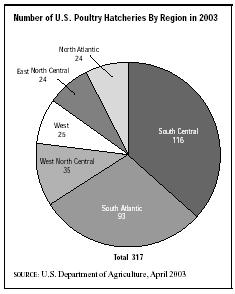SIC 0254
POULTRY HATCHERIES
This category includes establishments primarily engaged in operating poultry hatcheries on their own account or on a contract or fee basis.
NAICS Code(s)
112340 (Poultry Hatcheries)
This is a small industry, with less than 800 businesses operating primarily as poultry hatcheries in the United States, according to the U.S. Department of Agriculture. This number has been falling in the late 1990s and early 2000s due in part to massive vertically integrated operations that produce chickens in great quantities and raise them from hatchery to slaughterhouse.
As this industry is highly automated, most operations have a small staff. Roughly half of all poultry hatcheries employ fewer than five workers. The remainder of the establishments maintain staffs of various sizes.
A few companies controlled the majority of the hatchery market in the early 2000s. These were mainly giant, vertically integrated operations that had multiple interests in the poultry business. The remaining hatcheries were mostly family-run operations, with a majority making between $100,000 to $250,000 in annual revenues. Many of these smaller businesses produced chicks on a contract basis for the large poultry companies. In 2003, the number of chicken hatcheries declined from 322 to 317, while the number of turkey hatcheries fell from 59 to 58. Chicken egg capacity declined from 874 million to 861 million, while turkey egg capacity dropped from 45.7 million to 45.5 million.
In 2002, U.S. hatcheries produced 9.08 billion broiler-type chicks, up 1 percent from 2001. However, egg-type chicks hatched during this period decreased to 421 million, down 7 percent from 2001. Georgia, Arkansas, and Alabama, respectively, produced the most broiler-type chicks in 2002; Indiana, Iowa, and Pennsylvania led with the most egg-type chicks hatched.
The United States produced 38.1 billion pounds of poultry in 2002, up 3.2 percent from 2001. Domestic poultry consumption grew 5.7 percent in 2002 to nearly 76 pounds. Revenues at hatcheries may be on the rise because poultry production is expected to continue increasing in the early 2000s due to low feed costs and an increasing domestic demand for poultry—up 5 to 7 percent annually.
The nation's number one chicken producer, Tyson Foods Incorporated, is a vertically integrated operation with $24.5 billion in sales in 2003. Tyson, based in Springdale, Arkansas, employs more than 120,000 people across the United States and Mexico and operates 54 hatcheries. Although it is the industry leader, it is primarily classified as a poultry slaughterer and processor.
Another industry leader is Purdue Inc., based in Showell, Maryland, with $2.7 billion in sales and 20,000 employees. Atlanta-based Gold Kist Poultry Group, a farmers' cooperative formed in 1933, reported sales of

$1.85 billion in 2003 and employed 17,000 people. Wampler-Longacre Chicken Inc., acquired by Pilgrim's Pride Corp. in August of 2000, earns an estimated $370 million and employs 4,000 people.
Further Reading
Tyson Foods Inc. "About Tyson," 2004. Available from http://www.tyson.com/corporate/About/today.asp .
U.S. Department of Agriculture. Livestock, Dairy, and Poultry Outlook. Washington, DC: 27 January 2004. Available from http://usda.mannlib.cornell.edu/reports/erssor/livestock/ldp-mbb/2004/ldpm116t.pdf .
U.S. Department of Agriculture Economic Research Service. Poultry and Eggs: Trade. Washington, DC: 14 November 2004. Available from http://www.ers.usda.gov/Briefing/Poultry/trade.htm .
U. S. Department of Agriculture National Agricultural Statistics Service. "Hatchery Production 2002 Summary." Washington, DC: April 2003. Available from http://usda.mannlib.cornell.edu/reports/nassr/poultry/pbh-bbh/htpdan03.txt .
Comment about this article, ask questions, or add new information about this topic: